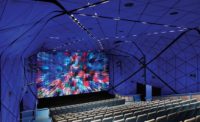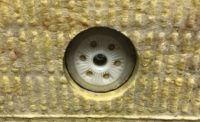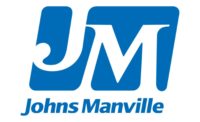Dismantling Mineral Wool Myths
Performance and compressive strength combine to make mineral wool a good choice for rainscreen systems.






By maintaining a space between a building’s cladding and exterior wall, rainscreen systems help protect the enclosure against the ravages of rain and moisture infiltration. While the visible aesthetics of a building’s cladding often receive all of the attention, a rainscreen’s performance is contingent upon a system of components working behind the scenes to protect against a common enemy—moisture. An important element of a rainscreen system is continuous insulation installed behind the cladding and in front of the actual water barrier. In addition to helping manage moisture, the continuous insulation in a rainscreen system also delivers other performance benefits including supporting energy efficiency, sustainability goals and more.
Contractors have many choices when it comes to the type of continuous insulation used in rainscreen systems. Among this array of options, mineral wool offers a number of benefits. Often favored for its non-combustible properties in perimeter fire containment systems, when used as a continuous insulation in rainscreen systems, mineral wool delivers several benefits that contribute to the system’s goals. These attributes include:
Hygrothermal Properties
As the function of a rainscreen is to protect a building from water infiltration in liquid and vapor form, mineral wool is well-suited to address both moisture and thermal challenges in the rainscreen system. Evaluation using WUFI hygrothermal analysis and expert interpretation shows that as continuous insulation helps move the dew point closer to the outer cavity of the wall; the potential for condensation to form inside the wall cavity is reduced.
As a vapor permeable material, mineral wool supports the movement of vapor through the cavity wall. This protects against moisture becoming trapped and helps avoid other concerns such as mold or mildew growth into the enclosure’s walls.
From a thermal perspective, pervading myths about mineral wool’s performance when it comes into contact with water can be misleading. While the insulating value of mineral wool is reduced when it becomes saturated (very unlikely given the defensive functions of the cladding and location in the rainscreen system), once dried, mineral wool’s thermal properties return to their original levels. Mineral wool delivers an R-value of up to 4.3 per inch (k-value 0.25) which makes it an efficient material by providing high thermal resistance and reducing thermal bridging when used in the rainscreen system. Because it reduces these thermal bridges which are a potential location for condensation, it also reduces the risk of mold and mildew, as well as associated poor indoor air quality.
Sustainability
“Consider the source and how it’s made” is good advice to follow when selecting building materials that will meet sustainability goals. Both the ingredients used in the manufacture of mineral wool and the process used to make it contribute to its sustainability. The Life Cycle Assessment represents an aggregate evaluation of a material’s inputs, outputs and potential environmental impact across its life cycle. As an example, Thermafiber mineral wool continuous insulation uses the third-party documented ICC-ES report to verify recycled materials content. Beyond ingredients, the energy impact of mineral wool is also environmentally friendly. For example, within one month a pound of mineral wool saves the same amount of energy as was consumed in its manufacture. Finally, mineral wool continuous insulation used in rainscreen systems can contribute points to various LEED credit categories particularly based on its content.
Fire Resistance
Mineral wool may be best known for its fire resistant properties. Non-combustible mineral wool will neither burn nor release smoke. Given the increase in non-traditional claddings (i.e. metal panels and plastic laminates), mineral wool provides a non-combustible material for compliance with International Building Code requirements for non-combustible wall construction such as NFPA 285 assemblies.
Jobsite Considerations
Before mineral wool is covered by construction in a rainscreen system it may be exposed to the elements on the jobsite. The durability that makes mineral wool well-suited for open-joint assemblies also makes it a good choice for this inevitable exposure. Mineral wool can be subjected to UV light for extended periods of time, as well as extreme temperatures and weather conditions without sacrificing its condition or losing R-Value.
Safety will always be priority number one on the jobsite. Given today’s tight labor market, it should be noted that mineral wool is quick and easy to work with. Installers can measure and use a serrated knife to cut the insulation. Its flexible properties allow it to conform to irregular surfaces and easily cut to accommodate penetrations.
At the end of the day, insulation’s performance in the rainscreen system is reliant upon proper installation. And when installing continuous insulation, contractors need to give thought to securing the insulation limiting the additional penetrations in air and water barriers. Insulation may be attached via a wide variety of fasteners. Some cladding systems are equipped with proprietary attachment systems. Other approaches include compression fitting into the wall, impaling pins, or using a system of girts or rails to attach the mineral wool to the cladding system.
To reduce thermal bridging and create more continuity, some attachment systems may be secured on the insulation outside after it has been installed. These applications require a semi-rigid product with higher compressive strength to ensure the cladding system stays under compression with little deflection over its lifetime. This type of mineral wool application was initially identified by density. However, it is actually the material’s compressive strength—its ability to resist deflection under load—that is critical to the performance of mineral wool in cladding attachment systems. Selecting the proper compressive strength to correspond with the requirements of the wall assembly is necessary for a successful installation and optimizing building performance.
A Mineral Wool Guide
Given the breadth of hanger and fastener systems available to install mineral wool continuous insulation, Owens Corning has developed a mineral wool attachment guide. The guide explains how insulation products are installed in various applications (including rainscreens) and how they interact with other attachment mechanisms in the assembly.
Specifying mineral wool as a continuous insulation in rainscreen applications can help support hygrothermal performance, energy goals, sustainability and of course, fire resistance. Selecting the proper compressive strength for the job allows building professionals to balance performance, economics and proper installation. Bringing together the benefits of material performance with the ease of mechanical installation, mineral wool provides a practical continuous insulation for rainscreen applications. W&C
Looking for a reprint of this article?
From high-res PDFs to custom plaques, order your copy today!









